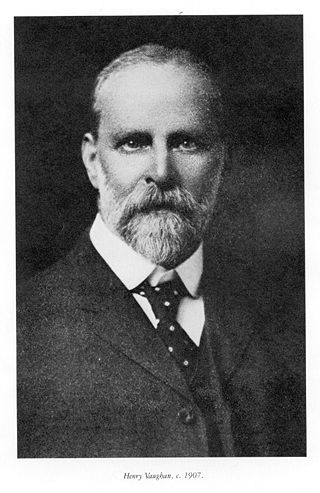
Henry Vaughan was a prolific and talented church architect who emigrated to America from England to bring the English Gothic style to the American branch of the Anglican Communion. He was an apprentice under George Frederick Bodley and went on to great success popularizing the Gothic Revival style.

St. John's Episcopal Church is a historic Episcopal church located on the village green in the village of Highgate Falls in Highgate, Vermont, in the United States. Built 1829–30, it is prominent local example of a Federal style church with Gothic Revival features. On September 3, 1976, it was listed on the National Register of Historic Places.

St. Thomas Episcopal Church is an historic Episcopal church located at 5 Hale Street in Dover, New Hampshire, in the United States. Founded in 1839, its building, designed by English architect Henry Vaughan, is an important example of his work, and was listed on the National Register of Historic Places in 1984.

The First Universalist Church is a historic church building on the corner of Pleasant, Elm, and Spring Streets in Auburn, Maine. It was built in 1876 to a design by John Stevens of Boston, Massachusetts, and has been a significant landmark in the city since its construction. It is a fine local example of Gothic Revival architecture executed in brick, and was listed on the National Register of Historic Places in 1979.
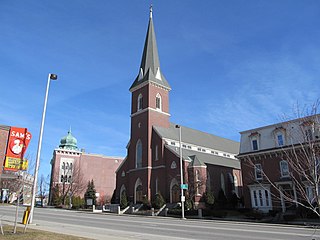
St. Joseph's Catholic Church is a historic former church building at 257 Main Street in Lewiston, Maine. Built 1864–67, it was the first Roman Catholic church in the city, and is one of only two surviving buildings in the state designed by Patrick C. Keely. It was listed on the National Register of Historic Places in 1989. The church closed in 2009, and was in 2013 threatened with demolition. Alternative uses for the structure are still being sought.

Saint Paul's Church, Chapel, and Parish House are a historic Episcopal Church complex at 15 and 27 Saint Paul Street and 104 Aspinwall Avenue in Brookline, Massachusetts. The Gothic Revival church building was designed by Richard Upjohn and built in 1851-52, and is the oldest surviving religious building in the town. The complex was listed on the National Register of Historic Places in 1985.

St. James Episcopal Church is located on East Main Street in Batavia, New York, United States. It is a stone Neo-Gothic structure built in the early 20th century.

St. Peter's Episcopal Church of Peekskill, New York, United States, is located on the north edge of the city's downtown. It is a three-building complex of stone Late Gothic Revival buildings on a half-acre dating to the late 19th century and added onto at successive later dates.

St. Paul's Church and Rectory is an historic Episcopal church at 279 Congress Street in Portland, Maine. Built in 1868 for a newly established congregation, it is a fine local example of Gothic Revival architecture, designed by English architect George Browne Pelham. It was listed on the National Register of Historic Places in 1978. The present pastor is Rev. Samuel L. Logan.

The South Parish Congregational Church and Parish House is a historic church at 9 Church Street in Augusta, Maine. Built in 1865, the church is a major Gothic Revival work of Maine's leading mid-19th century architect, Francis H. Fassett, and its 1889 parish house, designed by James H. Cochrane, is a rare example in the state of Stick style architecture. The property was listed on the National Register of Historic Places in 1980. The congregation was established in 1773, when the area was part of Hallowell.

St. Mary's Church is a Roman Catholic church at 41 Western Avenue in Augusta, Maine. Built in 1926, it is one of the city's finest examples of Gothic Revival architecture. It was listed on the National Register of Historic Places in 1987.
The Union Church of Vinalhaven is a historic church on East Main Street in the center of Vinalhaven, Maine. Built in 1899, it is a high quality example of Shingle style architecture, designed by one of its major promoters, John Calvin Stevens. It was listed on the National Register of Historic Places in 1984.
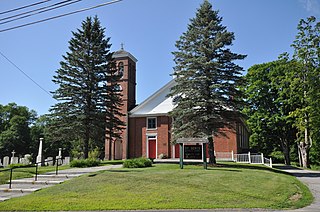
St. Denis Catholic Church is a historic Roman Catholic church at 298 Grand Army Road in North Whitefield, Maine. Built 1833–38, it is the third oldest Catholic church in New England. It was listed on the National Register of Historic Places in 1976. It remains in use as an active community of the Parish of St. Michael in the Diocese of Portland.
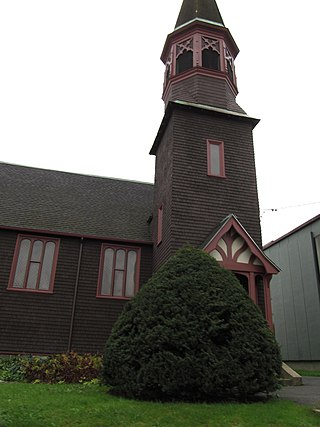
St. James Episcopal Church is a historic church at Center and Main Streets in the heart of Old Town, Maine. Built in 1892, the church is one of four works in the state designed by the Gothic Revival specialist Henry Vaughan. It is one of Old Town's few 19th century landmarks, and was listed on the National Register of Historic Places in 1974. Its current minister is the Rev. Jane White-Hassler.

St. Paul's Episcopal Church is a historic church building at Bridge Street and Vermont Route 14 in Royalton, Vermont. Built in 1836, it is a prominent early example of Gothic Revival architecture in the state, and is one of the oldest surviving public buildings in Royalton's historic village center. Now deconsecrated and maintained by the Royalton Historical Society, it was listed on the National Register of Historic Places in 2001.
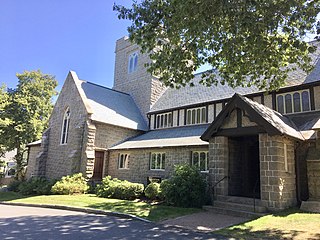
St. Mary's-By-The-Sea is a historic Gothic Revival church at 20 South Shore Road in Northeast Harbor, Maine. Designed by English architect Henry Vaughan and built in 1902, it is one of a number of architect-designed summer chapels built around the turn of the 20th century with funding from wealthy summer residents. The building was listed on the National Register of Historic Places in 2000. Its parish is also responsible for services at Saint Jude's Episcopal Church, another National Register-listed chapel in Seal Harbor.

The Glidden-Austin Block is a historic commercial building at 52 Main Street in Newcastle, Maine. Built in 1845, it is a prominent local example of mid-19th century commercial architecture, occupying a prominent location in the community's downtown area. It was listed on the National Register of Historic Places on April 28, 1975.
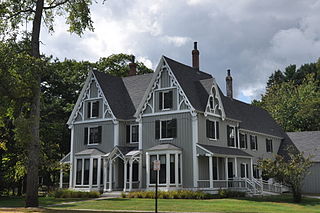
The Henry Boody House also known as the Boody-Johnson House, is an historic house at 256 Maine Street in Brunswick, Maine, United States. Built in 1849, it is an important early example of Gothic Revival Architecture, whose design was published by Andrew Jackson Downing in 1850 and received wide notice. It was listed on the National Register of Historic Places on 1975.

All Souls Congregational Church is an historic church at 10 Broadway in Bangor, Maine. Built in 1911, it is a landmark in the city, designed by the noted proponent of the Gothic Revival, Ralph Adams Cram. It was listed on the National Register of Historic Places in 1992. The church is affiliated with the United Church of Christ; the current pastor is Rev. Chad L. Poland.

The Hilliard United Methodist Church is a historic Methodist church in central Hilliard, Ohio, United States. The oldest religious structure in the community, it has been named a historic site.





















